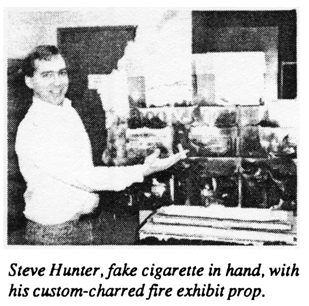







This question is of particular interest to me, an animation student with journalism degree. I've been trained in the notion of objectivity and truth and the many grey areas inbetween.
The fire department was called about suspicious smoke coming from the City Hall Graphics Department office (this was long before terrorism was an issue). The firefighters burst in to see employees burning paper to get an authentic charred look for a diorama about fire safety!
The cub reporter in me was excited. I could write about something ironic and lighthearted, a welcome respite the usual boring newsletter article, and best of all – true. Even better, I knew the guy who burned the diorama.
Unfortunately, my interviewee was a total dud. I thought his affable personality would yield tons of great quotes and anecdotes. Nope. He was as factual and dry as could be. I had to ask the same question about twenty different ways before he mentioned the irony of his situation. (You can see the final article here)

But I was noticing another irony. My “objective” journalistic techniques and training just pushed me away from the essence of the event. Sometimes the essential truth of something lies beyond its facts.
This is easier to accept with objective information. Everybody understands the difference between data and information. Most scientific disciplines have established methodologies to turn the former into the latter. Summarizing and organizing facts isn't viewed as fudging or manipulating data, but creating information.
For example, it's impossible to show a chart of our solar system accurately. The ratios of the planet's sizes and orbits relative to the sun are so severe, that the inner four planets would be indistinct specs on any frame compared with the Sun, and Jupiter would barely show up. So things get scaled. Many of our “truths” are based on loose summaries of dry facts scaled in a similar manner: “Good” weather essentially means the upper 70s and clear skies.
Usually, though, the big truths hide behind the little facts. The speed that somebody returns your calls or emails indicates their interest in you. It's human nature to look beyond the facts. Unfortunately, peering beyond the facts in the hope of finding truth unveils a grey area traveled by propagandists, liars and charlatans of all stripes. But all serious communicators, including animators, must go there.
All good documentaries wrestle with this issue, and this is precisely where animation can step in to illuminate this gap. After all, the fact that a husband punched his wife means much more than just the moment of impact.
Some of the best animated documentaries have dealt with recollections of trauma, like Sheila Sofian's “Conversations with Harris,” and “Survivors” as well as Dennis Tupicoff's “His Mother's Voice.” Both filmmakers utilized animation as the only honest way to capture the dream-like state that people often use as a coping device while experiencing or recollecting trauma.
People tend to develop their own script of a life event, especially traumatic ones. They often remember minor details peripheral to the actual horrors they are experiencing, like what they saw out of the window as they were being harmed. Over time this script gets re-edited until it solidifies into the way they remember an event from their own life. I would call this a “self-story.”
Sometimes biographers find their subject's “self-stories” do not square with the historical record. Again, this isn't necessarily deceitful: just ask any family to recall a relative's wedding from several decades past and contradictions will emerge. But for powerful, emotionally-charged events, a “self-story” may be the only truth possible.
This also means that fiction, in some ways, becomes emotional truth. As documentary animators enter into the realm of “self-story” they encounter their fellow storytellers from the fiction realm, who are searching for the same psychological truth for their fictional characters.
When I saw Sofian's “Survivors,” I recalled “What's Love Got to Do With It.” This hit movie from 1993 recreated Tina Turner's domestic abuse in a way that was painfully real. The film was just as obviously reconstructed as an animation - nobody mistook Angela Basset for Tina Turner - but it rang true for the audience.
Sometimes the emotional truth rings so true for an audience, it creates real events. The “Burning Bed” was a made for TV movie in 1984 starring Farrah Fawcett. Network TV still dominated the broadcast landscape, and it was one of the first movies to address domestic violence to a national audience. It became notorious for inspiring a copycat murder the night it was aired.
Picasso famously said “Art is the Lie that tells the truth.” This quote perfectly captures paradox and potential of animated documentary.
Mike Robinson